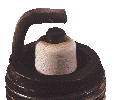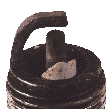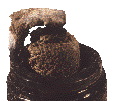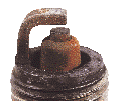Post by eg9 on Dec 6, 2007 7:49:43 GMT 10
What Does A Spark Plug Really Do?
The definition of the spark plug's purpose is straight forward. A spark plug seals the combustion chamber. It conducts a spark that is generated in the ignition coil into the combustion chamber and provides a gap for that spark to jump across. Finally, it conducts the heat it picks up in the combustion process to the cylinder head and into the cooling system. When a spark plug provides these three basic items, it is then capable of initiating the combustion process, There is a large amount of technology which goes into the design and manufacture of a spark plug that meets these requirements and provides long life and superior engine performance. It is important to remember that there is no design that will allow a spark plug to generate more voltage or hotter spark because the spark energy is generated in the coil. It is also important to remember that spark plugs do not produce heat. They pick up heat from the combustion chamber and move it to the cooling system. This basic definition of a spark plug will benefit you as the features and designs of spark plugs are described. It will also help you to better understand the value of reading spark plug firing end conditions.
READING THE PLUGS:
Normal Firing End

A grayish tan to while color indicates the correct heat range spark plug is in use, the fuel and ignition systems are in good shape and overall engine mechanical condition is good. Replace with new plugs of the same heat range. Refer to the owner's manual for recommended spark plug change interval.
Worn Out

Worn or rounded center and/or ground electrodes indicate excessive wear and can cause misfire during acceleration, hard starting or reduced fuel economy and damage to other secondary ignition components e.g., spark plug wires, coils and distributor cap with continuous use. When a plug has this type of appearance, it has simply exceeded its useful life. Replace with new spark plugs of the same heat range and design.
Detonation

In cases of light detonation, small black or gray spots will be noticed on the core nose of the spark plug. In cases of severe detonation, insulators may be cracked and/or chipped. The same high pressure waves created during detonation can break spark plugs, damage intake valves and break pistons. Make sure that the correct octane fuel is being used, assure proper operation of emission and computer systems, and assure the correct heat range of spark plug is being used.
Mechanical Damage

Bent and/or broken electrodes and core nose indicate mechanical damage caused by foreign objects in the combustion chamber or improper reach spark plugs, Remove the foreign object from the engine and check the owner's manual for proper spark plug application.
Overheated

Chalky white insulator with little or no coloration, accelerated electrode wear and possibly blistered or pitted electrodes are indications that a plug has overheated. The shell may also be discolored from light gray to a dark blue, almost black. Check for the correct heat range spark plug. Verify that ignition liming and air fuel mixtures are adequate. Engine overheating and restricted exhaust systems can also cause this condition.
Ash Deposits

Light brown deposits encrusted on the ground and/or center electrodes indicate ash deposits. This situation is caused by oil and/or fuel additives. When the deposits are found on only one side of the spark plug core nose, it is usually considered to be a problem with the cylinder head (valve stem seals or valve guides). When they are found on both sides of the spark plug, it is often considered to be a problem sealing at the piston rings. This condition can mask the spark and, in some cases, contribute to misfire. Check for worn valve guides and valve stem seals and/or piston rings. The spark plug is the correct heat range and was a victim of the engine's condition, not the cause of it. We does not recommend the use of fuel additives which leave deposits on the core nose of the spark plug.
Oil Fouled

Symptoms of oil fouling include black oily coating caused by poor oil control. This situation is more severe than what is seen with the ash-fouled spark plugs and usually represents advanced engine wear. When the oil enters the combustion chamber and covers the core nose of the spark plug, the spark no longer arcs across the gap. Rather it takes the easier path to ground by tracking down the oil on the core nose. This results in a complete cylinder misfire condition. Check for worn valve guides, valve stem seals and/or piston rings. Replacing the spark plug may help for a short time, but the new plug will soon foul.
Initial Pre-Ignition
Signs of the spark plug being hot or blistered and/or melted center and ground electrodes are indications of initial preignition. Check that the correct heat range spark plug is being used, assure ignition timing and air fuel mixture are appropriate, assure entire ignition system is functional and check its specifications. Routing of spark plug wires on some engines can contribute to cross induction which will lead to pre-ignition. Excessive carbon deposits in the combustion chamber may contribute as well.
Sustained Pre-Ignition

Melted center and/or ground electrodes and/or a melted insulator are symptoms of sustained pre-ignition. See initial preignition, description above. Also expect to find damage to the pistons and/or exhaust valves.
Splash Deposits

Small islands of contaminants on the insulator indicate splash deposits. Replace with new plugs of the correct heat range. The use of fuel additives, carburetor and choke cleaners or other aggressive solvents before installing new plugs is the most common cause of this condition.
Carbon Fouled

Soft, black, sooty, dry-looking deposits indicate a rich air fuel mixture, weak ignition or wrong heat range spark plug (too cold). These carbon-based deposits are conductive, much like oil fouling, and will allow the voltage coming out of the center electrode of the spark plug to track down the core nose rather than jumping the gap. This will result in an engine misfire and further aggravate the carbon fouled condition. Check for correct plug heat range. On fuel injected engines, check for sticking injectors, malfunctioning cold start valves and/or circuits. Also check for correct fuel pressure specifications. On computer controlled vehicles, the "limp home" computer mode will always result in a rich condition. Therefore, it is imperative that you check the operation and condition of the on-board computer system. On carbureted vehicles, check choke and choke pulloff, high float level, and needle and seat condition. On all engines, severe vacuum leaks can decrease manifold vacuum, resulting in a rich condition. Weak and/or damaged secondary ignition systems will fail to spark across the gap lowering combustion chamber temperatures and promoting carbon deposits. This condition could also result from continuous low speed driving or poor cylinder compression.
Fuel Additives

Red to purple deposits on one side of the core nose are an indication of a fuel additive. While many of these deposits are non-conductive and do not contribute to lack of performance, some fuel additives contain octane boosters that leave conductive deposits on the core nose. Care should be taken to select fuel additives which are compatible with ignition systems and do not contain conductive materials such as octane boosters.
The definition of the spark plug's purpose is straight forward. A spark plug seals the combustion chamber. It conducts a spark that is generated in the ignition coil into the combustion chamber and provides a gap for that spark to jump across. Finally, it conducts the heat it picks up in the combustion process to the cylinder head and into the cooling system. When a spark plug provides these three basic items, it is then capable of initiating the combustion process, There is a large amount of technology which goes into the design and manufacture of a spark plug that meets these requirements and provides long life and superior engine performance. It is important to remember that there is no design that will allow a spark plug to generate more voltage or hotter spark because the spark energy is generated in the coil. It is also important to remember that spark plugs do not produce heat. They pick up heat from the combustion chamber and move it to the cooling system. This basic definition of a spark plug will benefit you as the features and designs of spark plugs are described. It will also help you to better understand the value of reading spark plug firing end conditions.
READING THE PLUGS:
Normal Firing End

A grayish tan to while color indicates the correct heat range spark plug is in use, the fuel and ignition systems are in good shape and overall engine mechanical condition is good. Replace with new plugs of the same heat range. Refer to the owner's manual for recommended spark plug change interval.
Worn Out

Worn or rounded center and/or ground electrodes indicate excessive wear and can cause misfire during acceleration, hard starting or reduced fuel economy and damage to other secondary ignition components e.g., spark plug wires, coils and distributor cap with continuous use. When a plug has this type of appearance, it has simply exceeded its useful life. Replace with new spark plugs of the same heat range and design.
Detonation

In cases of light detonation, small black or gray spots will be noticed on the core nose of the spark plug. In cases of severe detonation, insulators may be cracked and/or chipped. The same high pressure waves created during detonation can break spark plugs, damage intake valves and break pistons. Make sure that the correct octane fuel is being used, assure proper operation of emission and computer systems, and assure the correct heat range of spark plug is being used.
Mechanical Damage

Bent and/or broken electrodes and core nose indicate mechanical damage caused by foreign objects in the combustion chamber or improper reach spark plugs, Remove the foreign object from the engine and check the owner's manual for proper spark plug application.
Overheated

Chalky white insulator with little or no coloration, accelerated electrode wear and possibly blistered or pitted electrodes are indications that a plug has overheated. The shell may also be discolored from light gray to a dark blue, almost black. Check for the correct heat range spark plug. Verify that ignition liming and air fuel mixtures are adequate. Engine overheating and restricted exhaust systems can also cause this condition.
Ash Deposits

Light brown deposits encrusted on the ground and/or center electrodes indicate ash deposits. This situation is caused by oil and/or fuel additives. When the deposits are found on only one side of the spark plug core nose, it is usually considered to be a problem with the cylinder head (valve stem seals or valve guides). When they are found on both sides of the spark plug, it is often considered to be a problem sealing at the piston rings. This condition can mask the spark and, in some cases, contribute to misfire. Check for worn valve guides and valve stem seals and/or piston rings. The spark plug is the correct heat range and was a victim of the engine's condition, not the cause of it. We does not recommend the use of fuel additives which leave deposits on the core nose of the spark plug.
Oil Fouled

Symptoms of oil fouling include black oily coating caused by poor oil control. This situation is more severe than what is seen with the ash-fouled spark plugs and usually represents advanced engine wear. When the oil enters the combustion chamber and covers the core nose of the spark plug, the spark no longer arcs across the gap. Rather it takes the easier path to ground by tracking down the oil on the core nose. This results in a complete cylinder misfire condition. Check for worn valve guides, valve stem seals and/or piston rings. Replacing the spark plug may help for a short time, but the new plug will soon foul.
Initial Pre-Ignition
Signs of the spark plug being hot or blistered and/or melted center and ground electrodes are indications of initial preignition. Check that the correct heat range spark plug is being used, assure ignition timing and air fuel mixture are appropriate, assure entire ignition system is functional and check its specifications. Routing of spark plug wires on some engines can contribute to cross induction which will lead to pre-ignition. Excessive carbon deposits in the combustion chamber may contribute as well.
Sustained Pre-Ignition

Melted center and/or ground electrodes and/or a melted insulator are symptoms of sustained pre-ignition. See initial preignition, description above. Also expect to find damage to the pistons and/or exhaust valves.
Splash Deposits

Small islands of contaminants on the insulator indicate splash deposits. Replace with new plugs of the correct heat range. The use of fuel additives, carburetor and choke cleaners or other aggressive solvents before installing new plugs is the most common cause of this condition.
Carbon Fouled

Soft, black, sooty, dry-looking deposits indicate a rich air fuel mixture, weak ignition or wrong heat range spark plug (too cold). These carbon-based deposits are conductive, much like oil fouling, and will allow the voltage coming out of the center electrode of the spark plug to track down the core nose rather than jumping the gap. This will result in an engine misfire and further aggravate the carbon fouled condition. Check for correct plug heat range. On fuel injected engines, check for sticking injectors, malfunctioning cold start valves and/or circuits. Also check for correct fuel pressure specifications. On computer controlled vehicles, the "limp home" computer mode will always result in a rich condition. Therefore, it is imperative that you check the operation and condition of the on-board computer system. On carbureted vehicles, check choke and choke pulloff, high float level, and needle and seat condition. On all engines, severe vacuum leaks can decrease manifold vacuum, resulting in a rich condition. Weak and/or damaged secondary ignition systems will fail to spark across the gap lowering combustion chamber temperatures and promoting carbon deposits. This condition could also result from continuous low speed driving or poor cylinder compression.
Fuel Additives

Red to purple deposits on one side of the core nose are an indication of a fuel additive. While many of these deposits are non-conductive and do not contribute to lack of performance, some fuel additives contain octane boosters that leave conductive deposits on the core nose. Care should be taken to select fuel additives which are compatible with ignition systems and do not contain conductive materials such as octane boosters.

